Can I Hook Up To Sewer Clean Out
And so you learned how to use React useState and how to emulate the traditional setState in a functional React component.
Just now you might be scratching your head and asking yourself, "How do I emulate a React component lifecycle?"
Don't worry, in this commodity will go over:
- What is React
useEffect - How to use React useEffect
- How to replicate the
componentDidMountlifecycle - How to replicate the
componentWillUnmountlifecycle - How to create cocky-sufficient code for
componentDidUpdatelifecycle
And so if you're non familiar with how to use information technology, read a previous commodity that covers near it; Introduction to React hooks.
Come back when you're ready!
What is React useEffect?
React useEffect is a part that gets executed for three different React component lifecycles.
Those lifecycles are componentDidMount, componentDidUpdate, and componentWillUnmount lifecycles.
Bones usage of useEffect
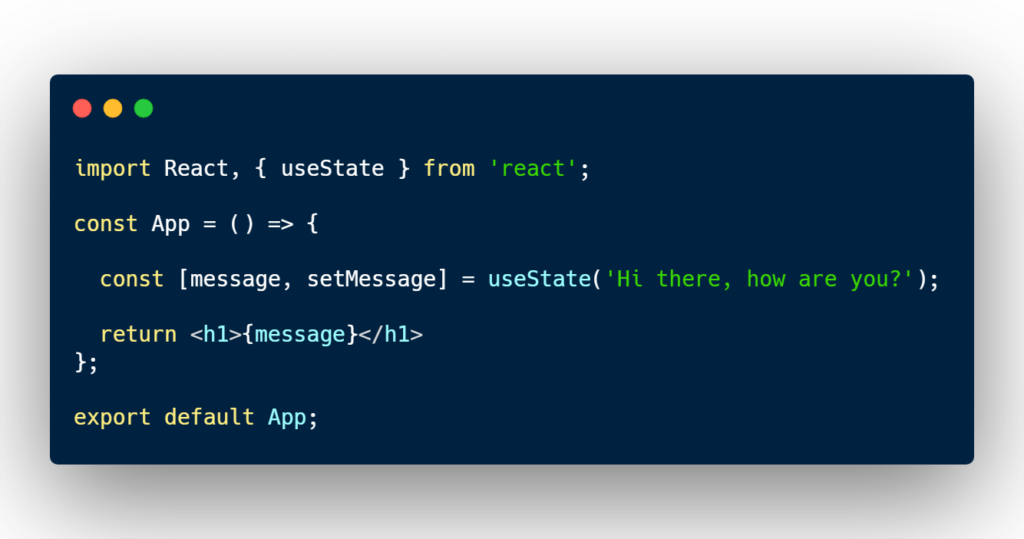
import React, { useState } from 'react'; const App = () => { const [bulletin, setMessage] = useState('Hi at that place, how are you?'); return <h1>{message}</h1> }; export default App; In the code case to a higher place, I'm using React useState to salvage a message.
I'm and then grabbing my land variable, message, and I'm printing it to the screen.

But now I want to useEffect to change the message a 2nd after the component has mounted.
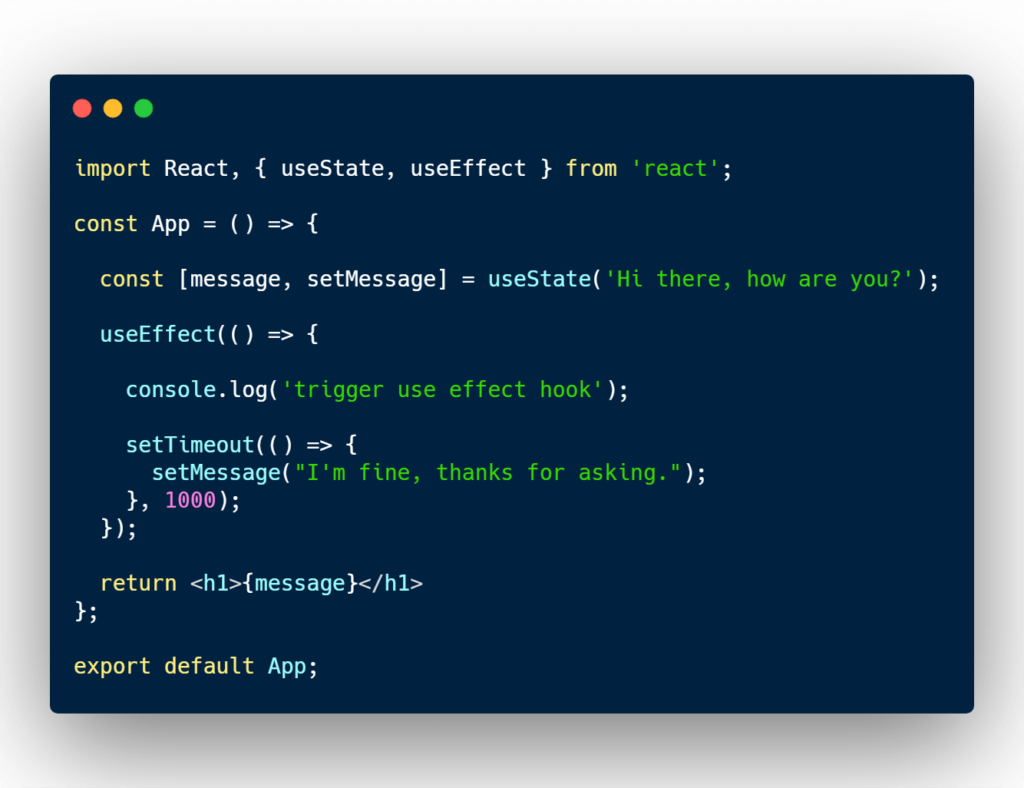
import React, { useState, useEffect } from 'react'; const App = () => { const [message, setMessage] = useState('Hello there, how are you?'); useEffect(() => { console.log('trigger use event hook'); setTimeout(() => { setMessage("I'g fine, thanks for asking."); }, m) }) return <h1>{message}</h1> }; consign default App; I've imported useEffect from the React library and I've added my effect under the useState line.
useEffect accepts a function as information technology's first argument. This function handler will have care of any side effects you like when it gets run.
The office is a callback function afterward one of the React component lifecycle has been triggered.
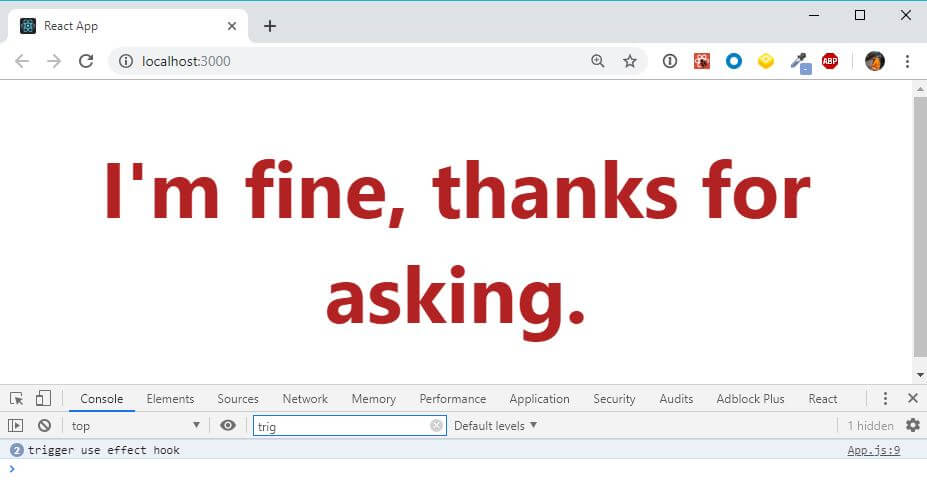
It worked! But at that place's a trouble. Take a look at the console log. The issue got triggered twice.
This behavior is not optimal, because if you lot have multiple effects or have new prop values beingness tossed from a parent component, information technology may trigger the consequence multiple times.
This may crusade inconsistency, weird side-effects, or freezing your app from an infinite loop.
Let'southward optimize this code a little bit more.
React useEffect: The componentDidMount hook
The goal now is to execute the setMessage function only on the componentDidMount lifecycle.
That manner if the App component receives whatsoever new props or if the state changes, the effect won't be triggered again.
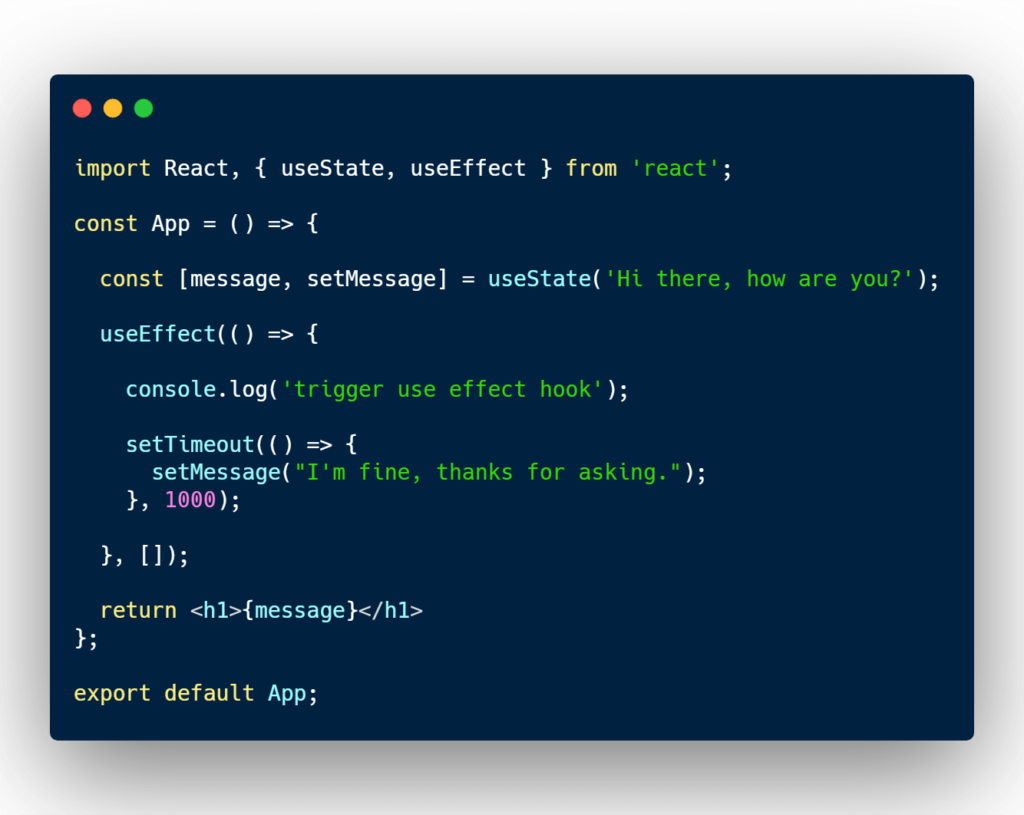
import React, { useState, useEffect } from 'react'; const App = () => { const [message, setMessage] = useState('Howdy at that place, how are you?'); useEffect(() => { console.log('trigger use consequence hook'); setTimeout(() => { setMessage("I'm fine, thanks for asking."); }, grand) }, []); return <h1>{message}</h1> }; consign default App; Tin can you see the difference from the old example?
If y'all haven't caught it yet, I added an empty array bracket ([]) as a second argument to the useEffect hook office.
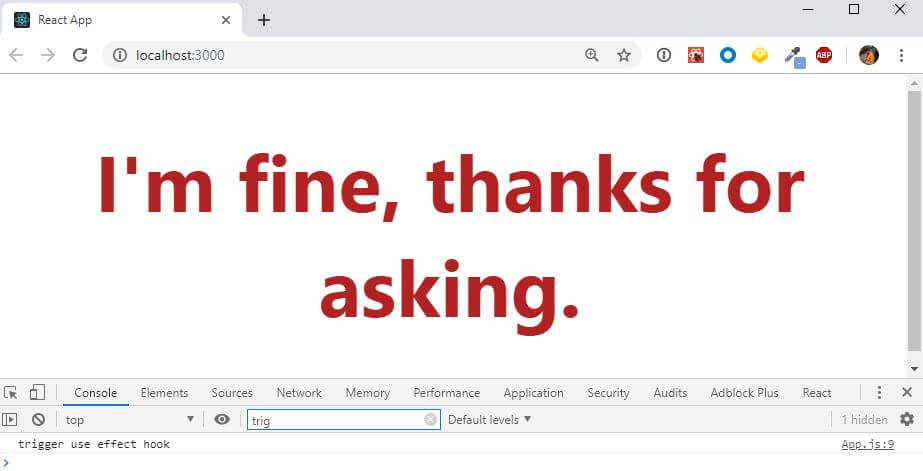
If yous have a look at the console log it only shows "trigger use effect claw" one time.
Here'due south an example output with another console log message that says, "App component rendered," after the effect office.
The 2nd console message should merely execute when the render lifecycle gets triggered.
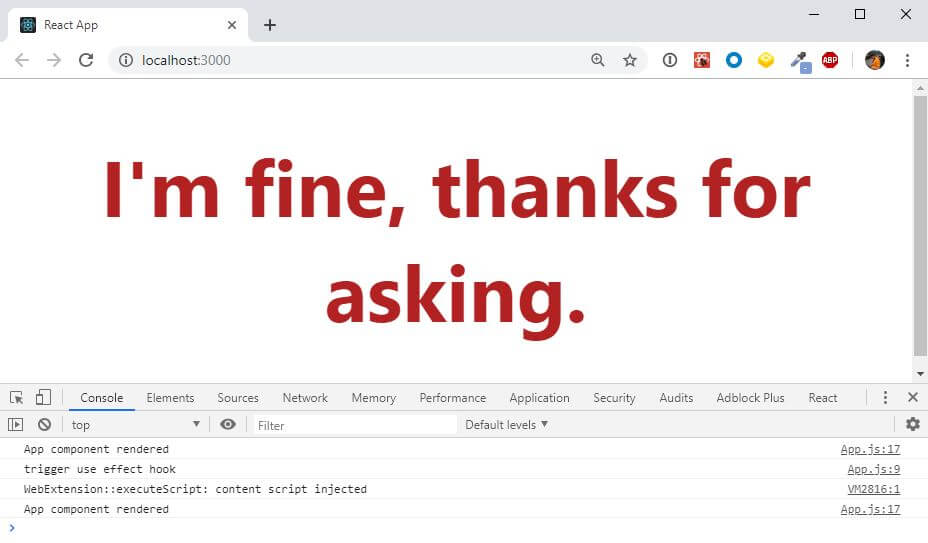
If we take a expect at the console log once again, we can see the society of the lifecycles that information technology went through.
- Rendered lifecycle
-
componentDidMountlifecycle - Rendered lifecycle
This is the normal behavior that you would see in a traditional React grade component.
Past running an empty array [] as a second argument, y'all're letting React know that your useEffect role doesn't depend on any values from props or state.
This will help yous avoid the componentDidUpdate lifecycle.
React useEffect: The componentWillUnmount hook
I showed an example how to avoid a trigger from a componentDidUpdate lifecycle with useEffect.
But what if you accept lawmaking that needs to get cleared up on a componentWillUnmount bike?
How do we replicate a componentWillUnmount lifecycle?
P.S. this lifecycle is also known as, the cleanup in a React hook function.
In the side by side example I will demonstrate a use case where you'll demand to clean up your code when a component will unmount.
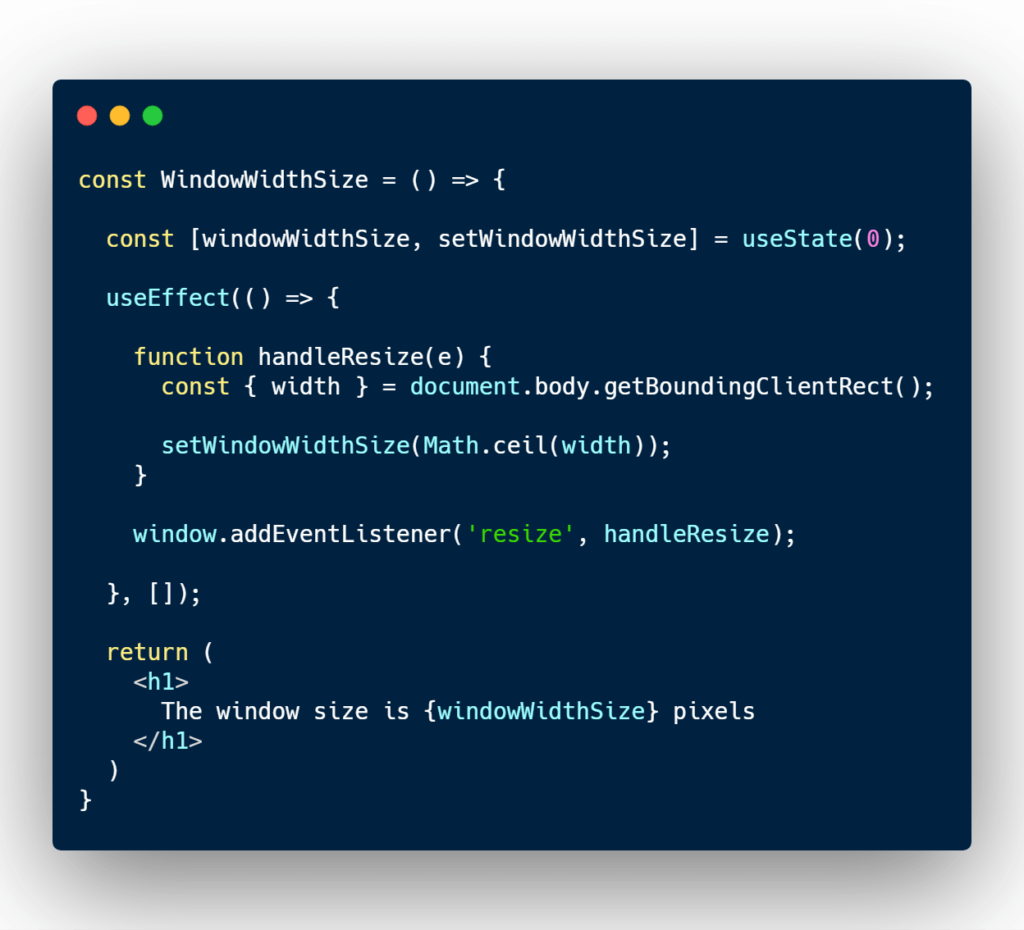
const WindowWidthSize = () => { const [windowWidthSize, setWindowWidthSize] = React.useState(0); React.useEffect(() => { office handleResize(e) { const { width } = document.body.getBoundingClientRect(); setWindowWidthSize(Math.ceil(width)); } window.addEventListener('resize', handleResize) }, []); return ( <h1> The window size {windowWidthSize} pixels </h1> ) }; In the paradigm higher up, I accept created a new function component called, WindowWidthSize.
The objective of this component is to print out the width size of the electric current window.
As you lot see tin see, I'thousand using useState to go on runway of the width size.
And correct below it I'thousand calculation a window consequence listener on the resize consequence.
So every time the user resizes the browser, it will get the new width, save it into state, and impress out the new width size.
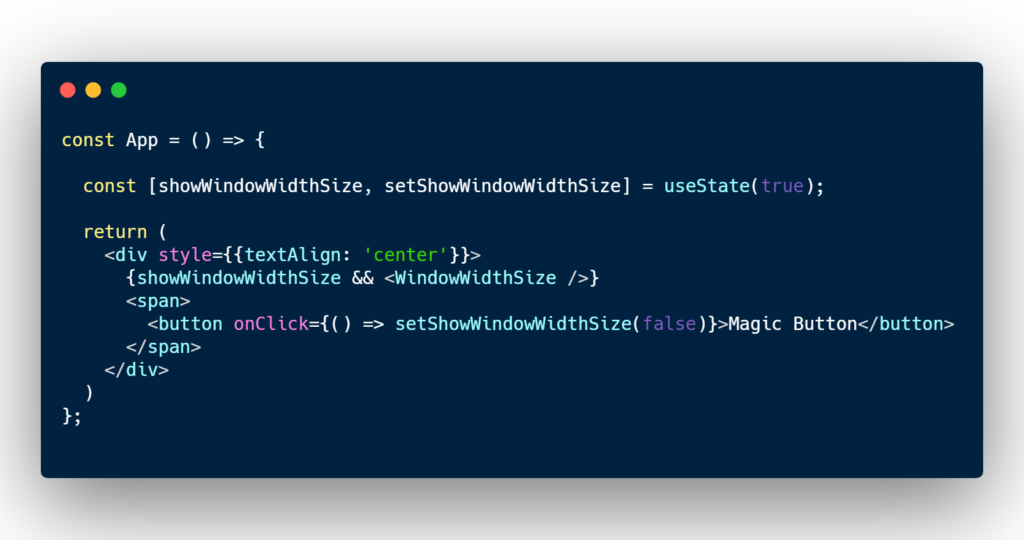
Okay, and then here nosotros have some other React component that uses the component WindowWidthSize, and it has a magical button.
When a user clicks this magical button, the WindowWidthSize component will vanish before your eyes.
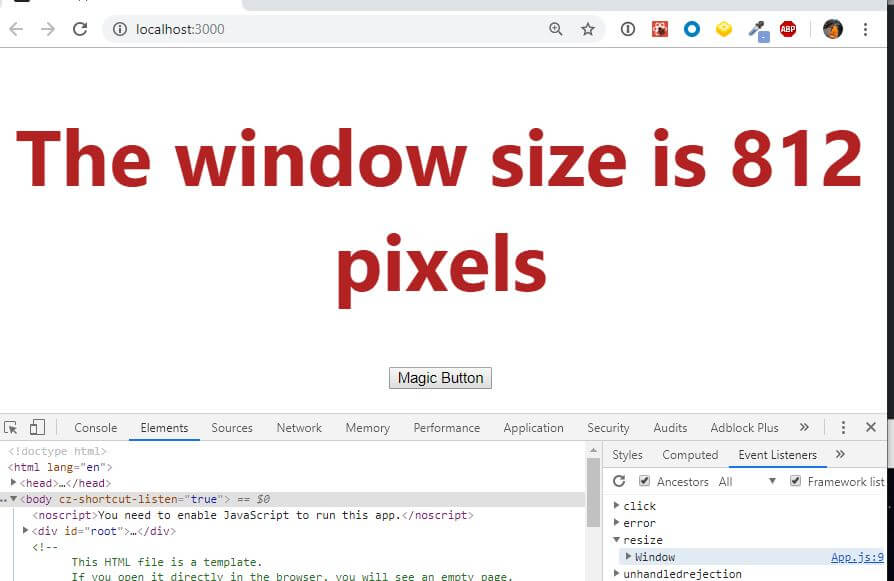
Great, the code works. And if yous see on the bottom right there is a bluish highlight section called Window.
The blueish highlight shows the window event listener I accept added.
When I click on the magical button, the WindowWidthSize component will no longer exist. Only there'due south a modest problem.
The window outcome listener is still lingering effectually.
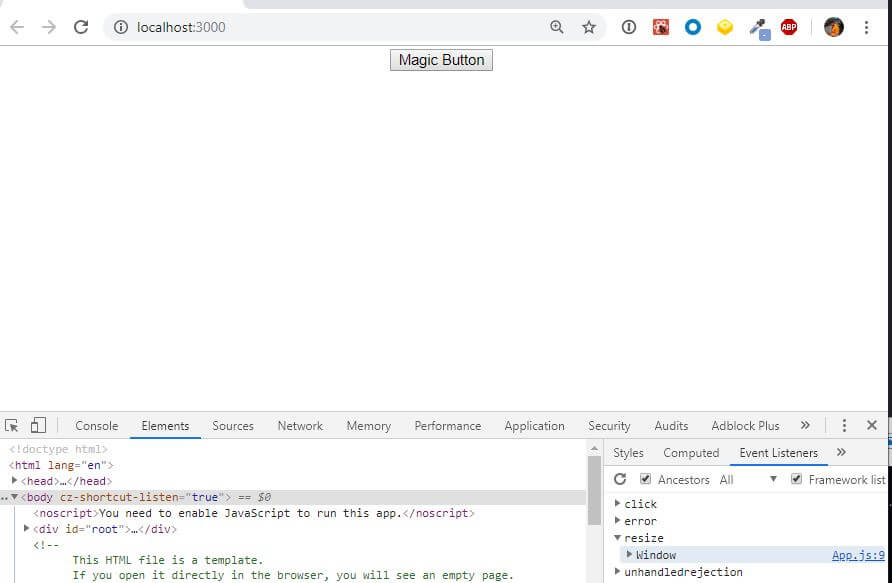
Situations like these are bad considering this is what causes memory leaks in your app.
And you don't want to exist greedy with your customers limited bandwidth.
Let'south use the make clean up technique that useEffect gives us, to get rid of this lingering window event.
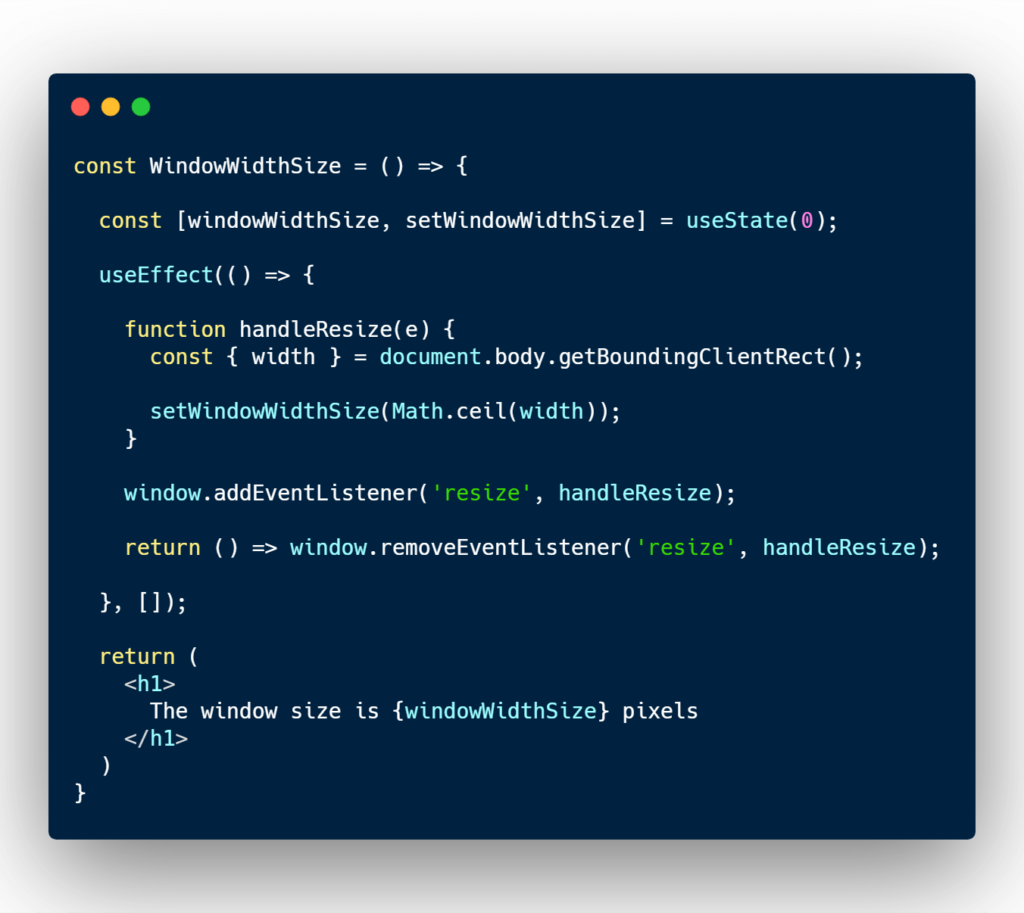
const WindowWidthSize = () => { const [windowWidthSize, setWindowWidthSize] = React.useState(0); React.useEffect(() => { office handleResize(e) { const { width } = document.torso.getBoundingClientRect(); setWindowWidthSize(Math.ceil(width)); } window.addEventListener('resize', handleResize); return () => window.removeEventListener('resize', handleResize); }, []); return ( <h1> The window size {windowWidthSize} pixels </h1> ) }; I added a return function inside the useEffect role.
And within the return function I'm removing the fifty-fifty listener that I originally added.
When a functional component un-mounts the logic inside the render part will go executed.
Then call back to clean upward your code if necessary by returning a function inside the useEffect function.
React useEffect: The componentWillUpdate claw
By default useEffect will trigger anytime an update happens to the React component.
This means if the component receives new props from its parent component or even when yous change the state locally, the effect will run over again.
In case yous need the effect to trigger on a componentDidUpdate lifecycle, y'all want to try and go far as self-sufficient equally possible.
If you don't, you volition run into an infinite loop of updates, and just run your computer hot.
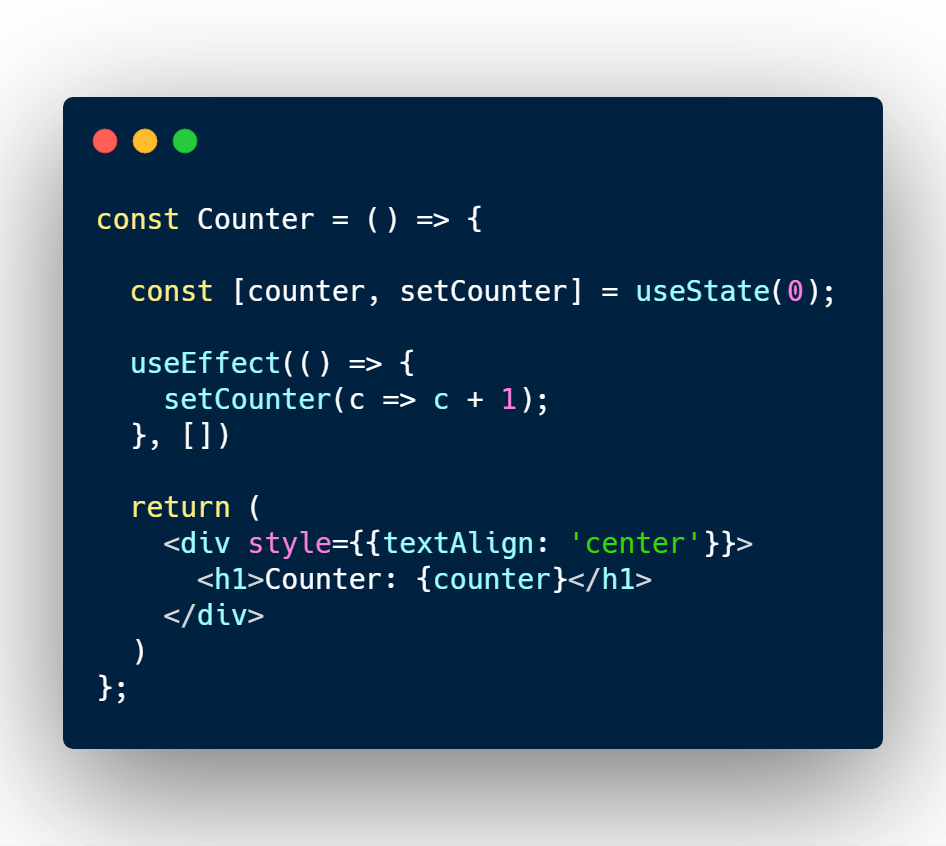
const Counter = () => { const [counter, setCounter] = React.useState(0); React.useEffect(() => { setCounter(c => c + 1); }, []); render ( <div way={{textAlign: 'heart'}}> <h1>Counter: {counter}</h1> </div> ); }; Right above is a elementary counter app. All it does is print a number to the user.
P.Due south. useState also accepts functions every bit an argument. This might be a better choice if you want a more accurate representation of the previous data.
I want this counter to increase on every 2nd.
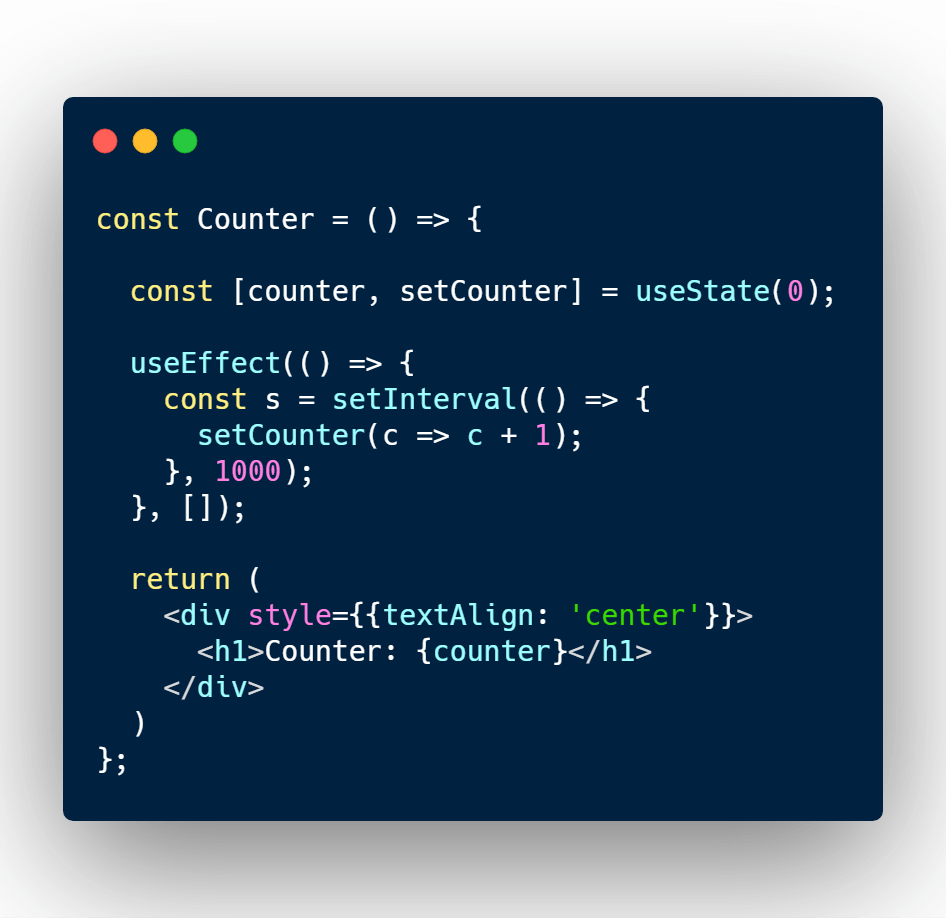
const Counter = () => { const [counter, setCounter] = React.useState(0); React.useEffect(() => { const due south = setInterval(() => { setCounter(c => c + ane); }, 1000); }, []); return ( <div way={{textAlign: 'middle'}}> <h1>Counter: {counter}</h1> </div> ); }; 
This is expert, but not good enough!
If you have multiple setStates inside this component or even receiving new props, this can throw the useEffect hook off track.
Causing your app to not be synchronized or just freeze.
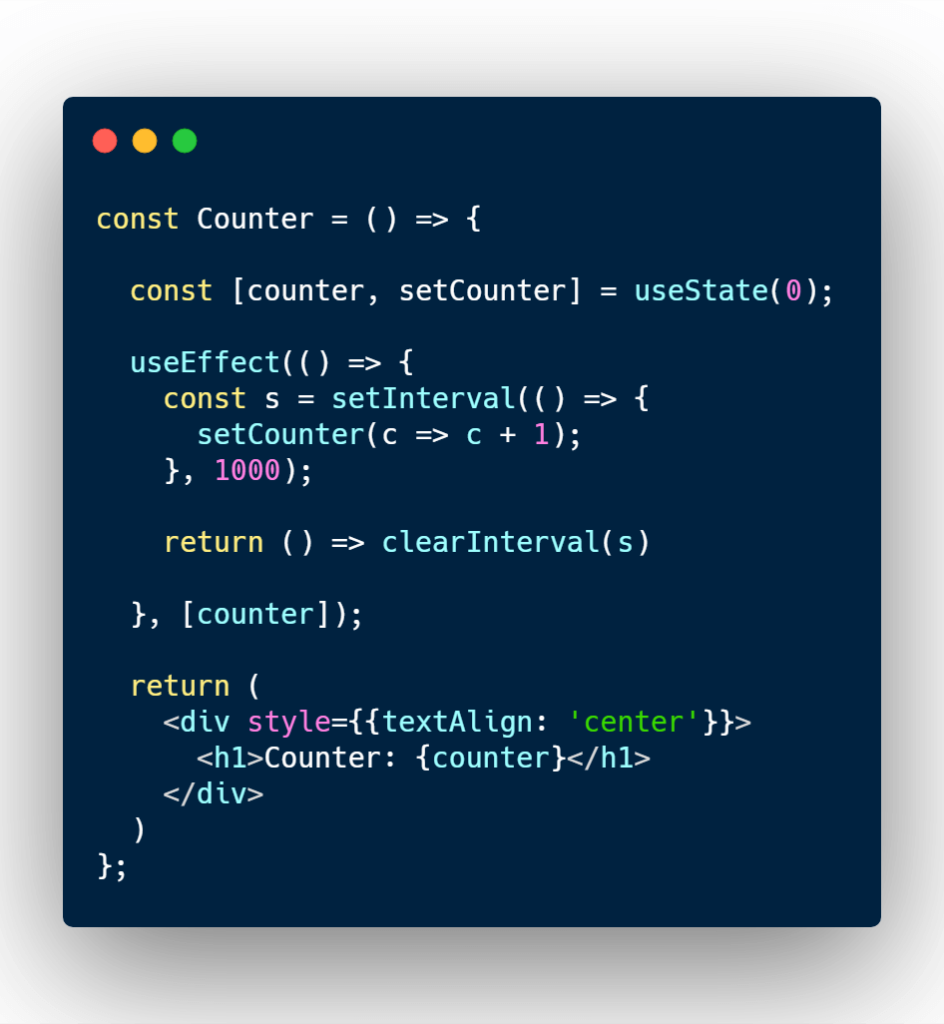
const Counter = () => { const [counter, setCounter] = React.useState(0); React.useEffect(() => { const s = setInterval(() => { setCounter(c => c + ane); }, 1000); return () => clearInterval(s); }, [counter]); render ( <div mode={{textAlign: 'heart'}}> <h1>Counter: {counter}</h1> </div> ); }; At present it's more self-sufficient.
Ane, I've added a clean upwards function to clear the interval whenever the component will unmount.
2, I've added the counter variable within the array bracket that's constitute in the second argument of the useEffect function.
This tells React to but trigger the effect when counter is a dissimilar value.
If counter has not changed in value, the effect won't execute.
This is helpful because you can safely add together multiple useEffects, setStates, or even pass downward new prop values, and it won't desynchronize your counter component.
Using Async and Await in React useEffect
React.useEffect does NOT allow you to add async in the callback function.
// This will cause your React application to break! React.useEffect(async() => { // ... stuff }, []); React is expecting a regular function and not a hope.
Only if you'd like to use async/await yous tin motion your code into its own function, and invoke it within React.useEffect().
async office fetchCats() { endeavour { const response = await fetch('url/to/true cat/api'); const { cats } = expect response.json(); panel.log(cats) // [ { proper name: 'Mr. Whiskers' }, ...cats ] } catch(e) { console.error(e); } } React.useEffect(() => { fetchCats(); }, []); Decision
React.useEffect is a basic hook that gets triggered on a combination of 3 React component lifecycles:
- componentDidMount
- componentDidUpdate
- componentWillUnmount
If you lot're planning to use React hooks you must know how to execute your effect on the right time.
Otherwise you might run into some problems for your users.
I like to tweet most React and post helpful code snippets. Follow me there if you would like some also!
Source: https://linguinecode.com/post/getting-started-with-react-useeffect
Posted by: dowellchader.blogspot.com


0 Response to "Can I Hook Up To Sewer Clean Out"
Post a Comment